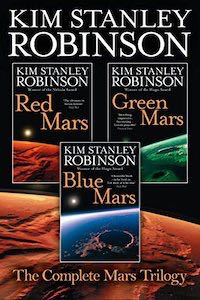Red/Green/Blue Mars by Kim Stanley Robinson
Each Friday, I intend to highlight a book I’ve recently enjoyed and want to share with you. I figure that a Friday is the best time to do this as you’ll have the whole weekend to really get into it.
A note on the links: they’re affiliate links in some cases, which means that if you click on them and then buy the book, I might get a small commission. In any case the price you pay does not vary, I don’t get to know who bought what, and none of your personal data is shared with me.
And none of the recommendations are paid for: these are all books which I personally have bought, enjoyed and want to share - no-one is asking me to do this.
Every now and then books come along that take on the challenge of telling a truly epic story, spanning decades or even centuries. The Mars Trilogy by Kim Stanley Robinson is one such series.
From the synopsis:
For eons, sandstorms have swept the desolate landscape. For centuries, Mars has beckoned humans to conquer its hostile climate. Now, in 2026, a group of 100 colonists is about to fulfill that destiny.
John Boone, Maya Toitavna, Frank Chalmers & Arkady Bogdanov lead a terraforming mission. For some, Mars will become a passion driving them to daring acts of courage & madness. For others it offers an opportunity to strip the planet of its riches. For the genetic alchemists, it presents a chance to create a biomedical miracle, a breakthrough that could change all we know about life & death. The colonists orbit giant satellite mirrors to reflect light to the surface. Black dust sprinkled on the polar caps will capture warmth. Massive tunnels, kilometers deep, will be drilled into the mantle to create stupendous vents of hot gases. Against this backdrop of epic upheaval, rivalries, loves & friendships will form & fall to pieces–for there are those who will fight to the death to prevent Mars from ever being changed.
The three books in the series are named after the different stages of the terraforming - Red Mars being first, Mars as it is today. Then comes plant life, basic at first, which gives us Green Mars. And when the water finally starts to flow, we reach Blue Mars.
These books are the product of Robinson’s incredibly detailed research - something which might put off a few readers, as he does delve into the science and theory behind terraforming more than the average reader might enjoy. That being said, if you enjoyed The Martian by Andy Weir, this is actually lighter on the science and more about the people and their issues and interactions. I think it’s safe to say that anyone with even a passing interest in Science Fiction would not feel there was too much science in this book!
Obviously the timescales involved in terraforming an entire planet don’t lend themselves to a super-snappy pace of action, although viewing a centuries-long process with the detachment necessary to observe gradual changes would be as dull as watching the Martian grass grow. Fortunately these novels do strike a good balance between the two requirements - focusing on the overarching goals and progress towards them when needed, and ‘drilling down’ to the human scale when key conflicts or decisions arise.
We follow the first few colonists - led by the first man to land on Mars a few years before - as they set up the base and set to work transforming the planet into one we can inhabit. Fairly quickly, the colonists come up with methods to prolong life & refresh fading memories, a plot device clearly engineered to allow us to follow the same characters through the entire series of novels, when without it we’d be looking at new generations of scientists in each book. This doesn’t stick out as such an obvious plant as it might sound, due to Robinson’s way of taking the possible implications of such a technology to their logical conclusions, and examining how people almost unchanging within a rapidly (at least to them) changing world would react.
This examination of the impacts of technology are a key part of this series - from the early days of the terraforming there are protesting voices wanting to keep the Martian environment as it was when we arrived. Compromises have to be made, and factions on both sides of the argument frequently stoop to sabotage and subterfuge to undermine the others. These are just a few of the lines that the group fractures along, and with a large cast of characters to draw on we’re able to see each of their perspectives and understand how one group might see another, and vice versa. At no point are we told, or even able to imply, who might be ‘right’ just as in real life - everyone has an opinion, some of them are very strongly held and there’s always someone who’ll die (or kill) to have their way.
If you like your science fiction with a side order of philosophy & politics, this is the series for you. Even if you don’t, it’s the sort of book that has a well-deserved place on a shelf near you for many of the same reasons as Lord of the Rings - it’s maybe not completely genre-defining in the way that series was, but it clearly shaped and influenced everything that came after it.
Click the images of each book to be taken to your store of choice, or use the links below:






